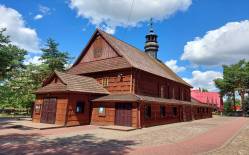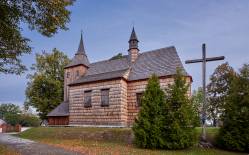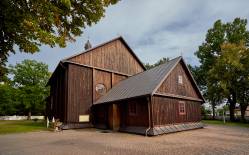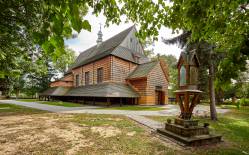Launched in Kolbuszowa in 1959, it was originally called Laskowiacy Regional Museum. The area of its interest corresponded to the territory once inhabited by the ethnographic groups of Lasowiacy and Rzeszowiacy. In 1974 the name Museum of Folk Culture was adopted and then in 1978 the most important exposition called the Ethnographic Park was opened. The outdoor museum of rural architecture comprises a large area spreading between Brzezówka (Domatkowa), Kolbuszowa and Kolbuszowa Górna. Situated along the River Nil, amidst the forests, over a number of ponds and close to farming fields, it occupies nearly 30 hectares. The exhibits on display here include over 80 wooden buildings, as well as various utensils, tools and items illustrating the daily life in villages inhabited by Lasowiacy and Rzeszowiacy in the late 19th/early 20th century. Most notably visitors can see here a large church of St. Mark the Evangelist from Rzochów, a number of windmills, watermill, oil mill, fire station with an exposition of old fire-fighting equipment, school building and village inn. The cultural and religious heritage of Lasowiacy and Rzeszowiacy is also reflected by exhibitions held in some of the buildings, related to handicrafts, farm work and housework as well as customs and rituals.
The museum in its holdings has large collections of old artefacts such as folk costumes, pottery, copper items, chromolithographic prints, folk sculptures, Polish painting as well as furniture, particularly the famous furniture made in Kolbuszowa.
The history of Christian and Jewish coexistence in Kolbuszowa is interesting. First Jews settled here in the 1600s. At that time, many of them were merchants, artisans and inn-keepers. In 1736 there was already a Qahal, with a synagogue and a mikvah; later a school and a hospital were built. In the mid-1700s Jewish people constituted half of the town’s population.
In 1866 the town adopted a unique coat of arms - with a Greek Cross, Star of David and two shaking hands.
A unique attraction which is worth seeing in the town is a very realistic crocodile, made of brass, squatting in the central square of the town. Visitors wonder what a tropical reptile has in common with the region. Well, this is a funny reference to the river Nil (or Nile) flowing through Kolbuszowa.
Photo: Krystian Kłysewicz, Kamila Wiśniewska-Hałka, Agnieszka Kołodziej
Gallery
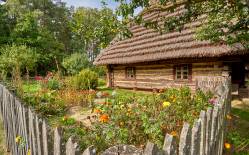
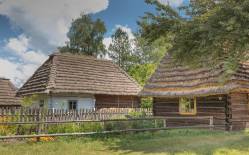
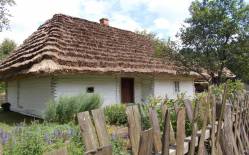
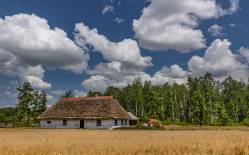
Recommended venues on the Trail



This website has been modernized with the financial support of the European Union under the Cross-Border Cooperation Programme Poland-Belarus-Ukraine 2014-2020. The responsibility for its content lies solely with the Podkarpackie Regional Tourism Board and cannot, in any case, be treated as a reflection of the position of the European Union, the Managing Authority, or the Joint Technical Secretariat of the Cross-Border Cooperation Programme Poland-Belarus-Ukraine 2014-2020.










